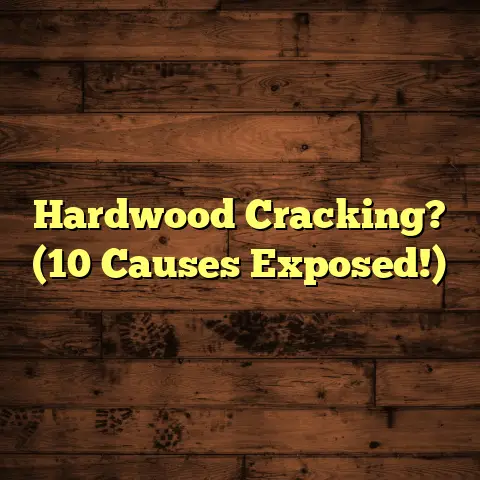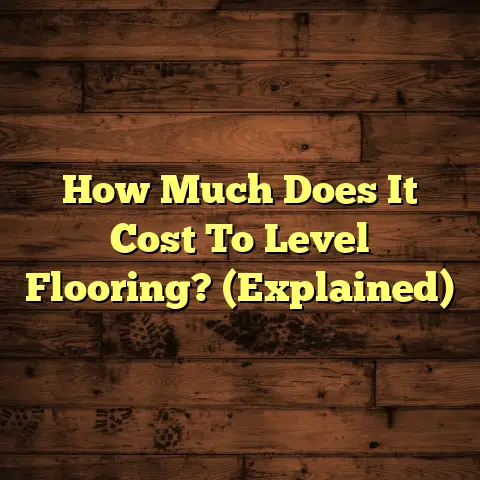Concrete Repair Cost Guide (Get a Free Quote!)
Concrete is tough, no doubt. But time, weather, and good old wear-and-tear can take their toll. Ignoring those little cracks or that scaling surface can lead to bigger, much pricier problems down the road.
That’s why understanding the costs involved in concrete repair is so crucial. Think of it as an investment in your property’s future. A little repair work now can save you from a complete replacement later.
In this guide, I’m going to walk you through everything you need to know about concrete repair costs. We’ll cover the types of damage, what influences the price, average costs, and, most importantly, how to get a free quote to ensure you’re getting the best deal.
Let’s dive in!
Section 1: Understanding Concrete Damage
Concrete damage isn’t just an eyesore; it’s a sign that something is wrong. Knowing what type of damage you’re dealing with is the first step in getting it fixed right.
1.1 Common Types of Concrete Damage
-
Cracks: Ah, cracks! The most common concrete woe. They come in all shapes and sizes.
-
Hairline Cracks: These are thin, surface-level cracks, often caused by shrinkage during curing. They’re usually not a big deal but can let water in, which is a big deal in colder climates!
-
Structural Cracks: These are wider and deeper, indicating a more serious problem with the foundation or load-bearing capacity. These are the ones that need immediate attention.
-
Settlement Cracks: These occur when the ground beneath the concrete shifts, causing the concrete to crack.
-
-
Spalling: This is when the surface of the concrete starts to flake or crumble away. It’s often caused by water seeping into the concrete, freezing, and expanding. Think of it like a concrete ice cube tray gone wrong!
-
Scaling: Similar to spalling, but it involves the surface peeling off in thin layers. This can be due to poor finishing, improper curing, or exposure to de-icing salts.
-
Heaving: This happens when the concrete lifts or rises, usually due to frost heave (water freezing in the soil beneath) or expansive soil.
1.2 Signs Your Concrete Needs Repair
Okay, so how do you know if your concrete is crying out for help? Here are a few telltale signs:
-
Visible Cracks: Obvious, right? But pay attention to the size and pattern. Are they getting bigger? Are there a lot of them?
-
Water Pooling: If water is consistently pooling on your concrete surface, it could be a sign of improper slope or cracking that’s preventing proper drainage.
-
Surface Flaking: If you see the surface of your concrete crumbling or peeling, it’s time to take action.
-
Uneven Surfaces: If your concrete is no longer level, it could be a sign of heaving or settlement.
-
Rust Stains: These can indicate that the reinforcing steel inside the concrete is corroding, which is a serious structural issue.
Section 2: Factors Influencing Concrete Repair Costs
Now, let’s talk money. The cost of concrete repair can vary widely depending on several factors.
2.1 Type of Damage
As you might guess, the type and severity of the damage are major cost drivers.
-
Minor Cracks: Filling small cracks with epoxy or sealant is a relatively inexpensive fix.
-
Extensive Damage: If you’re dealing with major structural cracks, spalling, or heaving, the repair will be more complex and costly.
2.2 Size of the Area
The larger the damaged area, the more materials and labor will be required, and the higher the cost.
- A small patch repair will be much cheaper than resurfacing an entire driveway.
2.3 Repair Methodology
There are several different techniques for repairing concrete, each with its own cost implications.
-
Epoxy Injection: This involves injecting epoxy into cracks to seal them and restore structural integrity. It’s a good option for hairline and structural cracks.
-
Concrete Resurfacing: This involves applying a new layer of concrete over the existing surface. It’s a good option for scaling, spalling, and surface imperfections.
-
Slab Jacking (Mudjacking): This involves pumping a grout mixture under the concrete slab to lift it back into place. It’s a good option for heaving or settling slabs.
-
Concrete Replacement: In some cases, the damage is so severe that the only option is to remove and replace the concrete. This is the most expensive option.
2.4 Material Costs
The cost of materials used in concrete repair can also vary.
-
Sealants and Fillers: These are relatively inexpensive.
-
Overlays and Resurfacing Materials: These can be more expensive, depending on the type and quality of the material.
2.5 Labor Costs
Labor costs will depend on the contractor’s experience, location, and the complexity of the project.
-
A highly experienced contractor may charge more per hour but may also be able to complete the job more quickly and efficiently.
-
Labor costs can also vary depending on the location. In general, labor costs are higher in urban areas than in rural areas.
Section 3: Average Costs of Concrete Repair
Alright, let’s get down to brass tacks. Here’s a general idea of what you can expect to pay for common concrete repair jobs. Remember, these are just averages, and your actual costs may vary.
3.1 General Pricing Guidelines
-
Crack Filling: \$3 to \$8 per linear foot.
-
Concrete Resurfacing: \$3 to \$7 per square foot.
-
Slab Jacking (Mudjacking): \$3 to \$6 per square foot.
-
Concrete Replacement: \$5 to \$10 per square foot.
3.2 Cost Comparisons by Region
Concrete repair costs can vary significantly by region due to factors like:
-
Labor Costs: As mentioned earlier, labor costs are generally higher in urban areas.
-
Material Costs: The cost of materials can also vary depending on the location.
-
Market Demand: In areas with high demand for concrete repair services, contractors may be able to charge more.
For example, according to HomeAdvisor, the average cost of concrete repair in California is higher than in Texas.
3.3 Price Ranges for Different Repair Techniques
Here’s a more detailed breakdown of price ranges for various repair methods:
| Repair Method | Price Range (per sq ft) | Notes |
|---|---|---|
| Crack Filling | \$3 – \$8 per linear ft | Cost varies based on crack width and sealant type (epoxy, polyurethane). |
| Concrete Resurfacing | \$3 – \$7 | Acrylic overlays are cheaper, while epoxy or polymer-modified overlays are more expensive but durable. |
| Slab Jacking | \$3 – \$6 | Cost depends on the amount of material needed to lift the slab. |
| Concrete Replacement | \$5 – \$10 | Includes demolition, removal, and pouring new concrete. Reinforced concrete or special finishes will increase the cost. |
Section 4: Getting a Free Quote
Now that you have a better understanding of concrete repair costs, let’s talk about how to get a free quote.
4.1 Importance of Obtaining Multiple Quotes
Getting multiple quotes is crucial for ensuring you’re getting the best price and service.
- It allows you to compare prices and services from different contractors.
- It gives you leverage to negotiate a better price.
- It helps you identify contractors who may be trying to overcharge you.
4.2 How to Request a Quote
Here’s a step-by-step guide on how to request a quote:
-
Identify Potential Contractors: Ask friends, family, or neighbors for recommendations, or search online for concrete repair contractors in your area.
-
Contact Contractors: Call or email the contractors and explain your concrete repair needs. Be as specific as possible about the type of damage, the size of the area, and any other relevant information.
-
Schedule On-Site Estimates: Ask the contractors to come to your property to assess the damage and provide a written estimate.
-
Review Estimates Carefully: Compare the estimates from different contractors, paying attention to the price, scope of work, materials used, and warranty.
4.3 Questions to Ask Contractors
When seeking quotes, be sure to ask these essential questions:
- Are you licensed and insured? This is crucial for protecting yourself from liability in case of accidents or damage.
- How much experience do you have with concrete repair? Look for contractors with a proven track record.
- What is your process for repairing the damage? Make sure you understand the contractor’s approach and that it’s appropriate for the type of damage you have.
- What materials will you be using? Ask about the quality and durability of the materials.
- Do you offer a warranty? A good warranty will protect you against defects in workmanship or materials.
- Can you provide references? Check references to see what other customers have to say about the contractor’s work.
Section 5: Long-Term Costs vs. Short-Term Savings
It’s tempting to go with the cheapest option, but when it comes to concrete repair, you often get what you pay for.
5.1 Cost-Benefit Analysis
Choosing low-cost repairs may save you money in the short term, but it can lead to higher costs in the long run.
- Low-quality repairs may not last as long: You may have to repair the same damage again in a few years.
- Low-quality repairs may not address the underlying cause of the damage: The damage may continue to worsen over time.
- Low-quality repairs may decrease the value of your property: Potential buyers may be turned off by shoddy workmanship.
Investing in quality repairs may cost more upfront, but it can save you money in the long run by preventing further damage, extending the life of your concrete, and increasing the value of your property.
5.2 Potential Risks of Delaying Repairs
Ignoring concrete damage can lead to more significant problems and costs down the line.
- Cracks can widen and deepen: This can compromise the structural integrity of the concrete.
- Water can seep into the concrete and cause further damage: This can lead to spalling, scaling, and heaving.
- The damage can become a safety hazard: Uneven surfaces or crumbling concrete can pose a tripping hazard.
Section 6: Conclusion
So, there you have it! A comprehensive guide to understanding concrete repair costs.
Summarize Key Points
Remember, understanding the type of damage, the factors that influence repair costs, and the importance of obtaining multiple quotes are all essential for getting the best value for your money.
Call to Action
Don’t wait until your concrete is crumbling before taking action. Assess your concrete repair needs today and reach out to local contractors for free quotes. By being proactive, you can ensure that you get the best value for your money and protect your property for years to come.
Ready to get started? Call a local Concrete Repair Contractor today!





